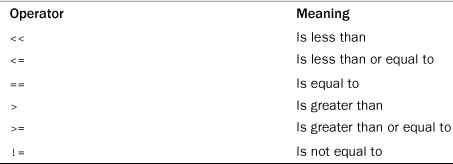Relational Expressions
Computers are more than relentless number crunchers. They have the capability to compare values, and this capability is the foundation of computer decision making. In C++ relational operators embody this ability. C++ provides six relational operators to compare numbers. Because characters are represented by their ASCII codes, you can use these operators with characters, too. They don’t work with C-style strings, but they do work with string class objects. Each relational expression reduces to the bool value true if the comparison is true and to the bool value false if the comparison is false, so these operators are well suited for use in a loop test expression. (Older implementations evaluate true relational expressions to 1 and false relational expressions to 0.) Table 5.2 summarizes these operators.
Table 5.2. Relational Operators

The six relational operators exhaust the comparisons C++ enables you to make for numbers. If you want to compare two values to see which is the more beautiful or the luckier, you must look elsewhere.
Here are some sample tests:
for (x = 20; x > 5; x--) // continue while x is greater than 5
for (x = 1; y != x; ++x) // continue while y is not equal to x
for (cin >> x; x == 0; cin >> x)) // continue while x is 0
The relational operators have a lower precedence than the arithmetic operators. That means this expression:
x + 3 > y - 2 // Expression 1
corresponds to this:
(x + 3) > (y - 2) // Expression 2
and not to the following:
x + (3 > y) - 2 // Expression 3
Because the expression (3 > y) is either 1 or 0 after the bool value is promoted to int, Expressions 2 and 3 are both valid. But most of us would want Expression 1 to mean Expression 2, and that is what C++ does.
